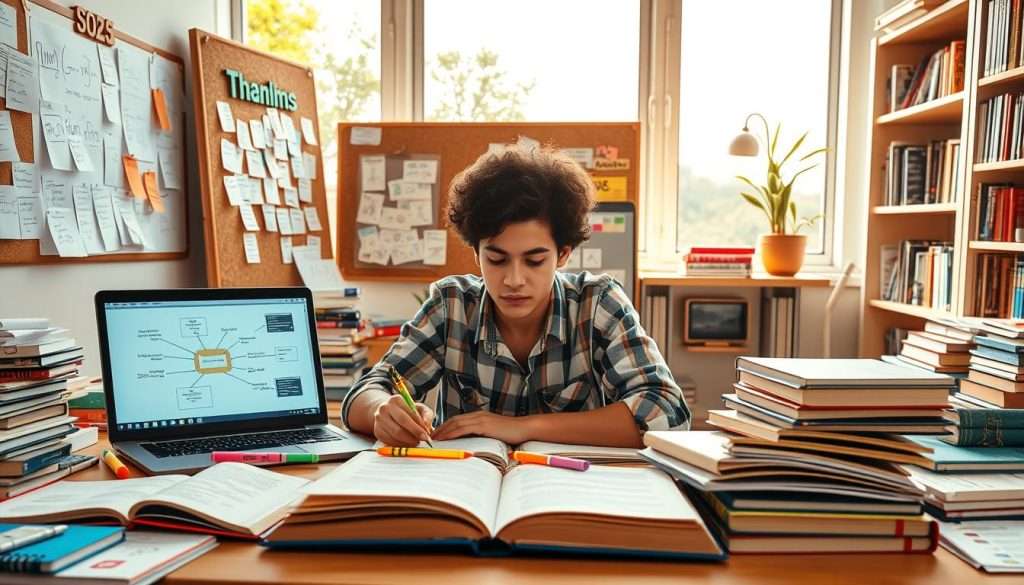We often get stuck in a learning cycle, studying the same way every day. Traditional learning methods can lead to shallow understanding. When we study topic A, then B, and then C, we miss connections between them.
To break this cycle, we need to vary our study techniques. This means changing how we study, using different senses, and practicing different skills. For example, if learning a new language, you might listen to a podcast one day and speak with a partner the next.
Key Takeaways
- Varying study techniques can improve retention and recall.
- Traditional learning methods can lead to shallow understanding.
- Using different senses and practicing different skills can help.
- Switching between different types of material keeps learning fresh.
- Effective study methods are key to achieving better results.
The Science Behind Varied Study Techniques
Let’s explore the world of learning science and discover the secrets of varied study techniques! Our brains react differently to different types of information. Knowing this can be a powerful tool in your learning journey.
How the Brain Processes Different Types of Information
The human brain is amazing at processing various types of information. But, it doesn’t handle everything the same way. For example, visual information like diagrams and charts is processed differently than text.
By using videos, flashcards, and written notes, you can engage multiple brain pathways. This can improve retention and recall.
Understanding the Forgetting Curve and Spaced Repetition
Research shows that our memory fades over time if not reinforced. This is known as the forgetting curve. Spaced repetition is a technique that fights this by reviewing material at longer intervals. This helps solidify it in your long-term memory.
By adding this to your study routine, you can greatly improve retention.
Research-Backed Benefits of Diverse Learning Methods
Studies have shown that diverse learning methods, like interleaving (switching between different types of material), lead to better learning outcomes. This approach helps you understand material deeply and apply it in different ways.
By mixing up your study techniques, you’re not just keeping things interesting. You’re also boosting your brainpower!
Why Traditional Study Methods Often Fall Short
Traditional study methods like rereading and highlighting don’t work well for many. We stick to what’s familiar, but these methods can be misleading. They make us think we understand material when we really don’t.
The Proven Limitations of Rereading and Highlighting
Rereading and highlighting are not active learning. Studies show they don’t help us remember or understand better. When we reread, we’re just seeing the material again, not really recalling it.
“The more you read, the more you think you know, but the more you don’t.”
Overcoming the Illusion of Knowledge Problem
We often confuse knowing something with feeling like we do. Just because we feel confident doesn’t mean we’re right. To really know, we need to test ourselves. Quizzing ourselves or explaining in our own words can show what we truly know.
Transforming Passive Learning into Active Engagement
To improve our study routine, we must switch to active learning. This means summarizing, making concept maps, or talking about topics. By using different ways to engage with material, we learn more and remember better.
| Passive Learning | Active Learning |
|---|---|
| Rereading | Summarizing in own words |
| Highlighting | Creating concept maps |
| Listening to lectures | Discussing topics with others |
By understanding the flaws in old study methods and using new, engaging ways, we can learn more. This leads to a better study routine.
How to Mix Up Your Study Practice Effectively
A dynamic learning approach is key to success. Mixing up your study practice boosts retention and understanding. It also makes learning more fun.
Implementing Interleaving Across Different Subjects
Interleaving means switching between different study materials or problems. This method helps deepen your understanding. For example, when studying history, you might jump between different periods or themes in one session.
Strategically Varying Your Study Environments
Changing where you study keeps your brain active. Try studying in places like libraries, coffee shops, or outdoors. This helps you remember information better in different settings.
Creating a Rotation of Different Study Methods
Rotating study methods keeps your studies fresh. You can mix various techniques to create a customized study plan that fits your style.
Combining Visual, Auditory, and Kinesthetic Approaches
Use different learning styles in your studies. Watch videos (visual), listen to podcasts (auditory), and do hands-on activities (kinesthetic). This multi-modal approach improves retention and understanding.
Balancing Digital and Analog Study Tools
Use both digital tools like apps and e-textbooks and analog methods like note-taking and flashcards. This mix keeps your study sessions interesting and prevents boredom.
By using these strategies, you can make your study practice dynamic and effective. Try out different methods to see what works best for you!
Time-Based Study Techniques for Optimal Learning
Learn how timing can make your study sessions better and more fun. The right time-based techniques can really boost your learning and memory.
Mastering the Pomodoro Technique for Focused Sessions
The Pomodoro Technique is great for staying focused. It means studying in 25-minute blocks, then taking a 5-minute break. After four blocks, take a 15-30 minute break. This keeps you sharp and stops burnout, making your study time more interactive study activities.

Scheduling Spaced Learning Sessions Throughout the Week
Studying at different times during the week can help you remember better. Spacing out your learning lets your brain process and remember information well. Studies show spaced repetition really helps with remembering things.
Implementing Time-Blocking for Subject Rotation
Time-blocking means setting times for different subjects. This keeps your study sessions interesting and varied. By setting times for each subject, you keep your study routine balanced and interactive.
Location-Based Study Strategies to Enhance Retention
Our brains connect memories with specific places. This makes where we study very important for remembering things. Studies show that our memory is tied to where we learn new stuff.
Leveraging Context-Dependent Memory for Better Recall
Learning in a certain place makes our brains link the info to that spot. To use this, try to study in the same place you’ll need to remember things. For example, study in the same classroom where your exam is.
Setting Up Multiple Effective Study Environments
Having different places to study keeps things interesting and stops boredom. Use different rooms at home, a library, or even outside. Each place can be linked to different subjects, making studying easier.
Alternating Between Indoor and Outdoor Study Spaces
Switching between indoor and outdoor study spots is great. Outdoor places offer a break from usual study spots, which can boost your mood and work better. Here’s a quick look at indoor and outdoor study spots:
| Study Environment | Benefits | Potential Drawbacks |
|---|---|---|
| Indoor | Controlled climate, fewer distractions | Potential for monotony, limited space |
| Outdoor | Fresh air, varied scenery, potential for increased creativity | Weather dependence, potential distractions |
Using different places for studying helps with memory and keeps things interesting. Try out different spots to see what works best for you!
Interactive Study Methods to Boost Engagement
Interactive study methods can change how you learn. They make studying fun and effective. You can use them for any subject, like languages, science, or art.
Organizing Productive Group Study Sessions
Group study sessions help you stay motivated and learn from others. It’s important to stay focused and make sure everyone contributes. Set clear goals for each session and rotate roles to keep things interesting.
Using the Teaching Method to Solidify Understanding
Teaching what you’ve learned is a great way to understand it better. It helps you organize your thoughts and explain things clearly. Try explaining a complex topic to a friend or family member to reinforce your learning!
Incorporating Digital Tools and Interactive Applications
Digital tools can make studying better. There are many apps and platforms that make learning interactive.
Maximizing Learning with Flashcard Apps and Spaced Repetition Software
Flashcard apps like Anki use spaced repetition to help you remember key terms. This method reviews material at longer intervals to help you remember it longer. Spaced repetition software is especially helpful for subjects that need a lot of memorization.
Engaging with Quiz-Based Learning Platforms
Quiz-based learning platforms are interactive and fun. Websites like Quizlet and Kahoot make learning competitive and engaging. They help you test your knowledge and find areas to improve.
| Tool | Description | Benefit |
|---|---|---|
| Anki | Flashcard app using spaced repetition | Improves memorization |
| Quizlet | Quiz-based learning platform | Tests knowledge and identifies weak areas |
| Kahoot | Game-based learning platform | Makes learning fun and competitive |
Using these interactive study methods can make learning more fun and effective. Try different techniques to see what works best for you. Don’t be afraid to try new things as you go.
Physical Elements to Incorporate into Your Study Routine
Adding physical elements to your study routine can make learning more fun and effective. Athletes, artists, and musicians all use this method to improve. Let’s see how you can apply it to studying.
Understanding the Movement-Learning Connection
Studies show that moving your body helps your brain work better. Exercise boosts memory, focus, and creativity. This is because it increases blood flow to the brain, giving it more oxygen and nutrients.
For example, students who exercise regularly do better in school than those who don’t. You don’t need to run marathons. Even a brisk walk can help.
Designing Effective Study-Exercise Combinations
So, how do you mix studying with exercise? Here are some varied studying strategies to try:
- Listen to study materials while walking or jogging.
- Use flashcards during workout breaks.
- Practice problems or past exams on a stationary bike.
Implementing Hands-On Learning Activities for Complex Concepts
Hands-on activities are great for tough subjects. You can use math manipulatives, do science experiments, or build models for history.
Here’s how different subjects can use hands-on learning:
| Subject | Hands-On Activity |
|---|---|
| Math | Using geometric shapes to understand spatial relationships |
| Science | Conducting experiments to demonstrate chemical reactions |
| History | Creating timelines or models of historical structures |
Adding physical elements and hands-on activities to your study routine can make learning more fun and effective. Try different combinations to find what works best for you.
Creating Your Customized Mixed Study Plan
Now that we’ve looked at different study methods, it’s time to make a study plan that fits you. We need to figure out how you learn best, match study methods to subjects, and make a flexible schedule.
Assessing Your Personal Learning Style and Preferences
Knowing how you learn is key to a good study plan. Think about your learning style: Do you learn better visually, through sound, or by doing things? Do you study better in quiet or with some noise? Try different settings to see what works for you.

Matching Specific Techniques to Different Subject Matter
Each subject might need its own study method. For example, you might use flashcards for history dates, and concept maps for science. Here are some methods for different subjects:
- For math: Practice problems, mix up problem types
- For languages: Flashcards, language exchange
- For sciences: Diagrams, summarize notes in your words
Building a Flexible and Sustainable Study Schedule
A good study schedule is essential for consistent studying. Here are tips for a flexible, lasting schedule:
Designing Daily Rotation Plans for Variety
Make a daily plan with different study activities. For example, mornings for notes, afternoons for problems, and evenings for reading.
Developing a Weekly Study Variety Calendar
Plan your week’s study activities. Switch between subjects or methods each day. Here’s an example:
| Day | Morning | Afternoon |
|---|---|---|
| Monday | Math practice | Language flashcards |
| Tuesday | Science reading | History summary |
By following these steps, you can make a dynamic learning approach that keeps studying fun and effective. The goal is to have an optimized study routine that you can keep up with long-term.
Conclusion: Embracing Variety for Long-Term Learning Success
We’ve looked at different study methods to spice up your learning. Using techniques like interleaving and spaced repetition can make your study plan unique. This way, you’ll understand and remember more.
Keep in mind, it’s key to be open to changing your study ways. Try out new things, like studying in different places or adding exercise. This will help you find a study routine that’s both good and fun.
Now, it’s time to use these tips to make learning more fun. By mixing up your study habits, you’re on the path to lasting success. So, start making your own study plan and watch your knowledge expand!

